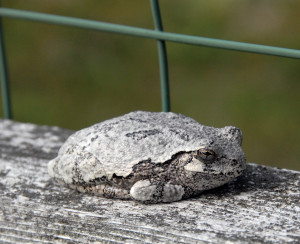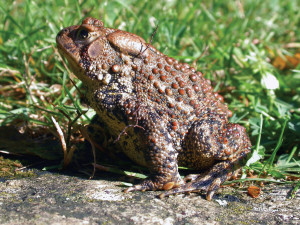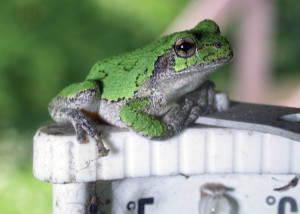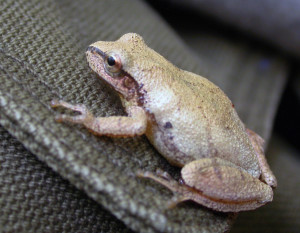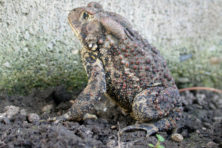Knee Deep in Frogs & Toads
- Share
- Tweet
- Pin
- Share

It was in 1906 that Mary Dickerson (1866–1923) had her outstanding book, The Frog Book, published. It proved to be so popular that Dover Publications came out with its own copyrighted publication in 1969. Of the dozen or more references available on frogs, toads, salamanders and other amphibians, this is still the book I refer to first. Her writing strongly reflects her closeness with nature.
She said of the Wood Frog, “It is to the ground what the Chickadee is to the trees – a gentle spirit of the woods. Its appearance and ways are always in harmony with the subdued light, the quiet, and the delicate mosses and frail ferns that live in the shade of great trees.”
Perhaps that is why I admire the Wood Frog, not only for its “ways” but more for its choice of environment. What a beautiful, highly bred creature and how magnificent are its surroundings. During my years working at The Ridges Sanctuary in Baileys Harbor I soon learned, with snow still lingering along the shaded south margins of the open wetland, the downright rollicking breeding time of the Wood Frog is during mid to late April, between Labrador and Deerlick Ridges.
Every year this swale is a temporary wetland, which means that fish cannot survive in that environment. This condition is perfect for the hatching tadpoles to be able to survive long enough to be able to become land creatures, a typical sequence of nearly all amphibians.
To my knowledge, the Wood Frog is the earliest breeder of all frog species native to Door County. The others include: Northern Spring Peeper, Western Chorus, Cope’s Gray Tree Frog, Eastern Gray Tree Frog, Green, Leopard and Bull Frogs. I’ve heard a few undocumented reports of some Pickerel Frogs in the county, appearing considerably like Leopard Frogs. Quite a few people have also reported hearing the unmistakable night serenades of Bull Frogs, their low “jug-o’-rum” voices lacing the late May wetland air, in spots where the water is deep enough for them to survive year-round.
Seldom have I actually seen a Western Chorus Frog. My only proof of their presence in Door County is having heard their unusual calls, which can be imitated by running your fingernail over the stiff teeth of a plastic comb. You’re in for a challenge in trying to see one of these roughly one-inch-long, pale green to tan frogs with olive-brown stripes running lengthwise along the body; this coloring provides them with excellent camouflage. Expect to hear them in wet willow seeps and old moist fields.
The Spring Peeper’s call is easy to distinguish from others. Dozens of these frogs, busy vocalizing during a warm spring night in some shallow woodland swamp, can produce enough noise to be heard from a considerable distance. Put on some boots and carefully walk out to the middle of their “concert hall” some evening and you will be amazed at the magnitude of song pouring out of so tiny an animal. Carry a flashlight with you and locate one of the singers. What will appear as a great white bubble is its throat sac filled with air ready to be turned into a musical “pee-EEP, pee-EEP.” It has been said that to hear a large group of Spring Peepers from a distance is like hearing sleigh bells.
One of our most familiar and commonly seen frogs of the spring and summer is the Northern Leopard Frog. A good many budding young naturalists honed their interest early on by perfecting their skill at hand-catching these frogs that are well known for their ability to avoid predators by using a series of rapid, zigzag jumps.
The Northern Leopard Frogs’ presence in meadows considerably distant from water has led many people to call it the “meadow frog.” This handsome bronzy-brown-green creature has irregularly shaped dark spots on its back. According to the experts the Pickerel Frog, having very spotty distribution in our county, differs from the Leopard Frog in that its dark spots are more rectangular and it has bright yellow or orange on the concealed surfaces of its legs.
It was during the mid-1970s that, for reasons unknown at the time, the Leopard Frog population began to nose-dive to the point where it was downright difficult to locate a single frog during some summers. Fortunately their numbers have begun to recover, and some healthy ponds and wetlands now support an increasing number of these handsome and valuable amphibians.
The Gray Tree Frog has become my and my wife Charlotte’s favorite frog simply because we’ve so frequently encountered them in or near our garden during the past 20-plus years. Our first experiences with them was not in seeing them but hearing their very bird-like vocalizations – a gentle, slightly upward-slurred series of staccato notes, very smooth, musical, ringing and far-reaching. Quite often we’d encounter one placidly perched and perfectly camouflaged on the gray, weathered, cedar cross-member of our garden gate.
The undersides of its thighs are a bright, but seldom-seen yellow – the most often seen part of this little anuran is the topside. The tips of its toes are extended into small discs, like miniature suction cups, that facilitate clinging to very smooth surfaces such as glass.
One of its astonishing feats is the Gray Tree Frog’s strength of jumping, almost as though it was flying. This reminds me of a favorite verse written long ago by an unknown author. A part of the verse goes like this: “A frog he like a bird almost. When he hop he fly almost. When he stand he sit almost, and when he sit, he sit on what he ain’t got almost.”
A close relative of the Gray Tree Frog is the Cope’s Gray Tree Frog. Its song is short and raspy, not musical in the slightest. This handsome little frog is usually bright green on its upper surface, and can often be found perched and resting during the day, near to where it had been feeding on insects.
There is a small thermometer fastened on the exterior of the house, within a few inches of our upstairs bathroom window, about six feet off the ground. A few summers ago we were delighted to see a Cope’s Gray Tree Frog perched on top of the thermometer. Apparently this “lookout” proved to be a good hunting perch at night, with the nightlight in the bathroom attracting insects to the window.
The Green Frog, second largest in size to the Bull Frog, also requires permanent water and is seldom seen more than a few feet from the shore. Its unusual vocalizations are a giveaway as to who the “singer” is. Imagine strumming a banjo having only one loose string. It amounts to a low “gung-gung-gung.”
It’s difficult in the spring to associate a downright ugly, cold-blooded, venomous Eastern American Toad with one of the most splendid, high-pitched, long sustained musical trills from a wild creature. At first guess, few people could match this two to three-inch warty brown creature with that extended continual, pleasant and dreamy aria, upwards of 30 seconds long.
Years ago I made a tape recording at the Mud Lake Wildlife Area of several dozen male toads all singing together at the same time. Each one had a slightly different pitch, making for what I thought was a delightfully dissonant concert. It is said that the trill rate of the toad’s tremulous whistle is about 30 per second. His throat is puffed out to a nearly globular shape, forming a vocal sac. The sound is produced by drawing air in at the nostrils and passing it back and forth from lungs to mouth and over its vocal mechanism (somewhat like our vocal chords), while the inflated throat sac acts as a resonator.
Since toads are hatched in water, spend much of their adult life away from water, and eventually return to water to breed, it means toads seen in our garden or flower beds had to make an overland one-way journey of about two miles. They are capable of over-wintering, for example, in gardens by simply digging their way downward about two to three feet to where they’ll be safe from freezing.
Beginning 50 or more years ago, there has been a steady global amphibian decline. Many factors play into this terrible predicament, including habitat loss, climate change, elevated levels of ultraviolet radiation, decreasing prey, acid rain and pollution of air, land and water. When people ask me, “What’s so valuable about frogs, toads and other amphibians?” I tell them that none of these conditions were brought about by the amphibians, but rather by people.
I feel, as many others do, that frogs and toads are important by virtue of their very existence. Some provide high quality food for other wild animals. Unquestionably frogs and toads are important in controlling some insect populations. More and more, amphibians are being recognized as being very valuable indicators of environmental health. Perhaps the same factors that affect amphibian population also affect humans, and we should pay close attention.
To me, frogs and toads have been fascinating animals to watch, listen to, and admire. I shall never forget my little friend Scott Nelson, who at the time was in the second grade class I was teaching about frogs and toads. After class, Scott came to me and asked, “Mr. Lukes, do you know how deep in the pond frogs go in winter?” My response was, “No Scott, do you know?” And his answer was, “Knee deep, knee deep, knee deep!” Today Scott works in the field of conservation.
Photography by Roy Lukes.

